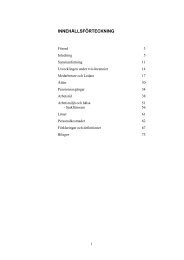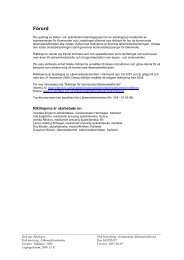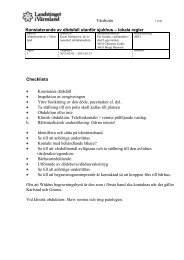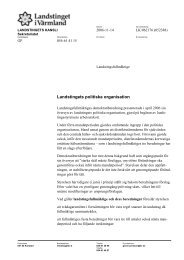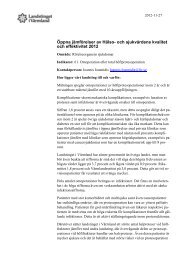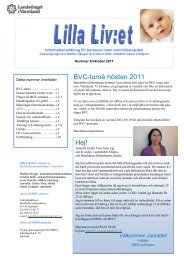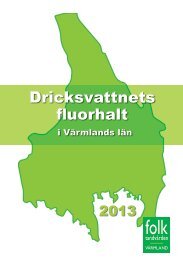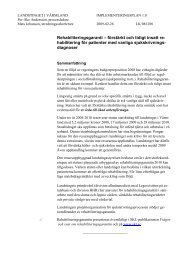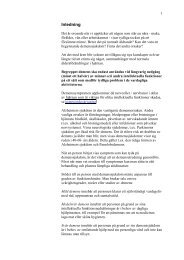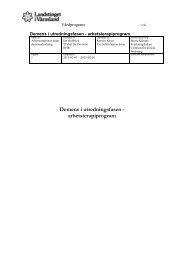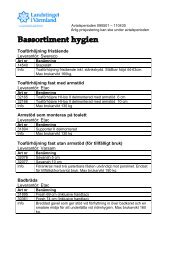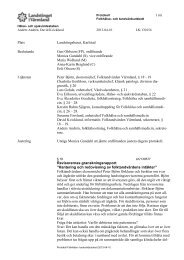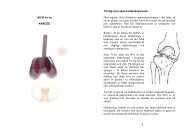Severs skada – paradigmskifte gällande diagnostik och behandling?
Severs skada – paradigmskifte gällande diagnostik och behandling?
Severs skada – paradigmskifte gällande diagnostik och behandling?
You also want an ePaper? Increase the reach of your titles
YUMPU automatically turns print PDFs into web optimized ePapers that Google loves.
and pain history in weeks before the randomization<br />
between the two groups, starting with either heel<br />
wedges or heel cups (Table 1). All boys continued<br />
their high levels of physical activity during the study<br />
(Engstro¨ m’s activity index level E n 5 38, and D<br />
n 5 6).<br />
Pain was significantly lower in the heel cup group<br />
compared with the wedge group. For activity A and<br />
B, the effect of the cup was OR 5 0.22 (Po0.001<br />
[0.15, 0.34]) and OR 5 0.18 (Po0.001 [0.12, 0.27]),<br />
respectively, thus reducing the odds score for pain to<br />
a fifth compared with the wedge (ordinal data). There<br />
was also a significant effect of time for activity A<br />
OR 5 0.93 (P 5 0.001) and for activity B OR 5 0.93<br />
(P 5 0.002), which means that pain was reduced with<br />
time as an independent variable (Table 2). We did<br />
check duration of pain at baseline and age as<br />
explanatory variables, but none of them had any<br />
significant effect in the model.<br />
When able to freely choose in the final second part<br />
(intervention 3), 34 boys (77%) chose the heel cup<br />
and 10 (23%) chose the heel wedge (Fig. 2). No one<br />
preferred to stop using insoles.<br />
There was a continuous reduction of pain between<br />
the three intervention phases for both groups. After<br />
each intervention phase, the pain reoccurred in the<br />
next baseline phase (Fig. 3). During the prolonged<br />
phase with the free choice of insole (8 weeks compared<br />
with 4 weeks), the median pain was 0.5. After<br />
26 weeks when the study was concluded, the median<br />
value for pain was 0 (IQR 1).<br />
The 1-year follow-up questionnaire showed that<br />
pain relief during the study period was good or<br />
excellent in 40 answers (n 5 41) for the chosen insole,<br />
and in 14 (n 5 40) for the non-chosen alternative.<br />
During the following year, 14 were pain free throughout,<br />
12 still had pain when being active on their level<br />
and 14 had pain that disappeared in 3 months<br />
(median), where six boys had relapses thereafter<br />
(n 5 40). The number of boys that used insoles after<br />
1 year was 22. Nineteen of the boys assessed its effect<br />
on pain as excellent or good. Five boys found the<br />
insoles (all cups) inconvenient in the post-study<br />
phase.<br />
Discussion<br />
This study shows that treatment with heel cup was<br />
superior to treatment with heel wedge for relieving<br />
pain during sport activities in Sever’s injury without<br />
reducing physical activity, indicating that the reduction<br />
of repetitive impact forces in heel strike is the<br />
most important factor for pain relief.<br />
The result is valid for several reasons. Our randomized<br />
study was focused on a single treatment regime<br />
for heel pain: insole treatment (Figs 1 and 2). There<br />
44<br />
Sever’s injury; treat it with heel cup<br />
was no advertisement or active recruitment made and<br />
the boys were included in the same season during 3<br />
following years. There were two parallel groups with<br />
the same overall experiences during the randomized<br />
first half of the study with baseline phases and<br />
crossover treatment (Fig. 2). All pain recordings<br />
were self<strong>–</strong>assessed with no influence from the investigators.<br />
All boys continued being physically active at<br />
the same high level throughout the study period. The<br />
studied group appears to be typical for physically<br />
active boys, 9<strong>–</strong>15 years old, seeking Health Care for<br />
heel pain (Table 1). We put the upper inclusion limit<br />
in pain history before start to 26 weeks to avoid the<br />
most refractory cases, where 14% had a pain history<br />
between 4 and 6 months at start. No one had a pain<br />
history shorter than 4 weeks (mean 11 weeks). At the<br />
end of phase B2, 39 boys still had pain (n 5 44) (Fig.<br />
3). Less than 10% (n 5 3) of all the boys fulfilling the<br />
inclusion criteria at our clinic did not want to<br />
participate. Hence, missing cases were few and the<br />
reasons for dropping out were not related to the<br />
study design.<br />
We chose to include only boys with Sever’s injury,<br />
because boys totally have dominated in frequency,<br />
probably due to different gender preferences and<br />
training patterns (Lutter, 1992).<br />
Previous guidelines for treating Sever’s injury are<br />
built on principles for adults suffering from heel pain<br />
(Micheli & Ireland, 1987; Ishikawa, 2005; Kasser,<br />
2006). Scientific evidence for the effect of these<br />
treatment regimens are lacking. Insole treatment<br />
together with limitations in activity are the most<br />
frequent advice, and the wedge is the most frequent<br />
insole advice in the literature (Peck, 1995; Staheli,<br />
1998; Kasser, 2006). The approach is to limit the<br />
stress to the apophysis <strong>–</strong> Achilles tendon complex by<br />
placing the foot in slight equinus. It points out the<br />
apophysis and its growth plate, the physis, as the<br />
morphologic origin of pain. The second proposed<br />
alternative in the literature is to correct malalignment<br />
particularly pronation or flat-footed running, by a<br />
molded plastizote orthosis or a heel cup (Micheli &<br />
Ireland, 1987; Madden & Mellion, 1996).<br />
Ogden et al. (2004) questioned the concept of<br />
apophysitis. Instead, he found a traumatic stress<br />
fracture of the immature calcaneal trabecular bone,<br />
visualized with MRI. Ogden therefore singled out the<br />
repeated and intense impact forces as responsible for<br />
the damage of the trabecular bone close to the physis,<br />
the metaphysis and not to the apophysis. His arguments<br />
are supported by the fact that sports like ice<br />
hockey and cross country skiing, with very little<br />
impact forces compared with soccer and running,<br />
but with great shear stresses to the apophysis in pull<br />
off, are very uncommon as exacerbating sports for<br />
heel pain (Orava & Virtanen, 1982; Micheli & Ireland,<br />
1987). The thesis by Jo¨ rgensen (1989) (includ-<br />
e45



